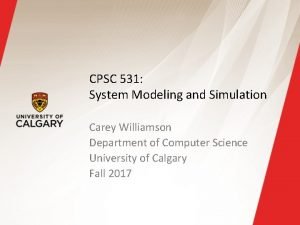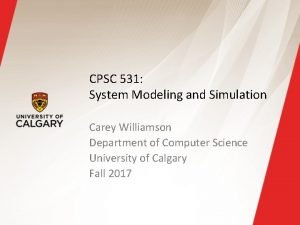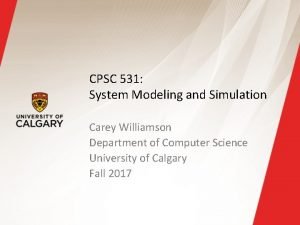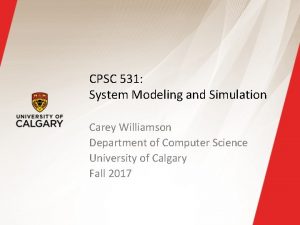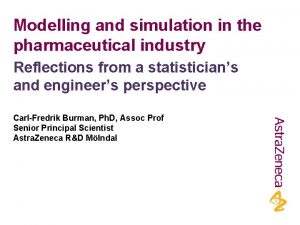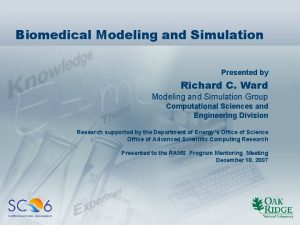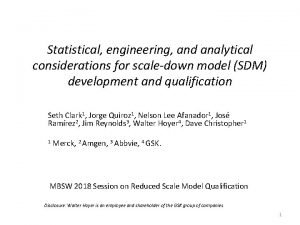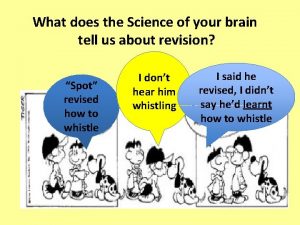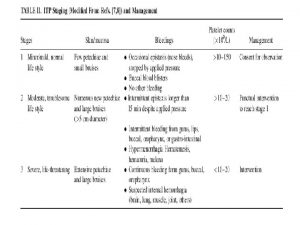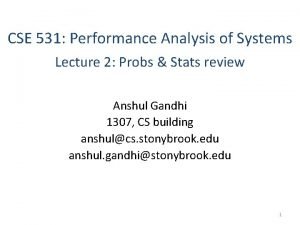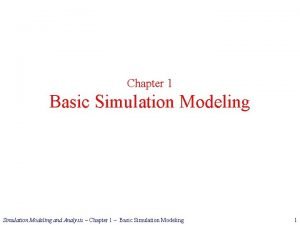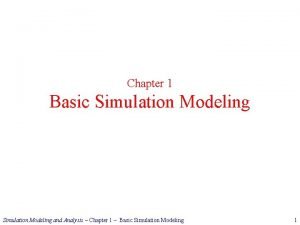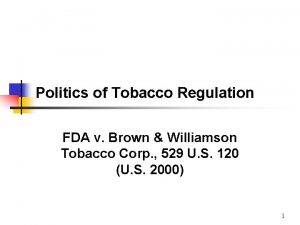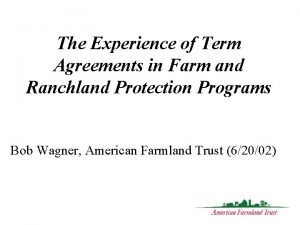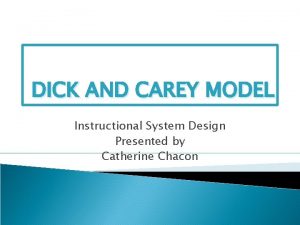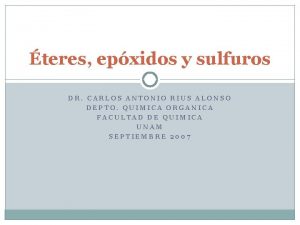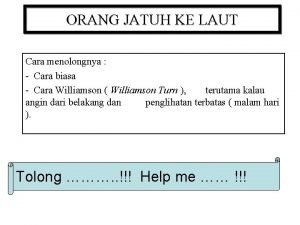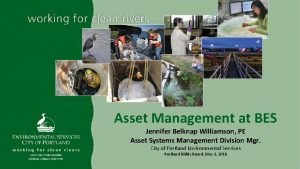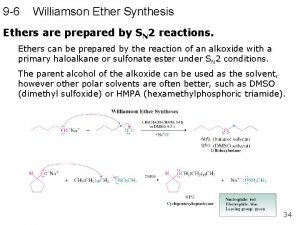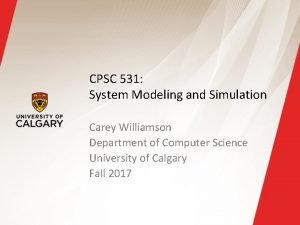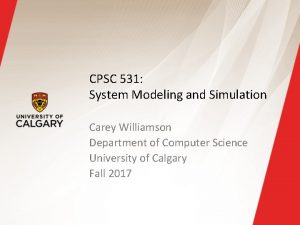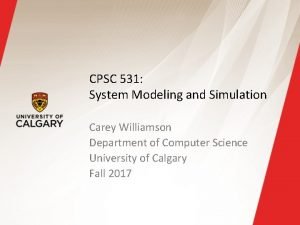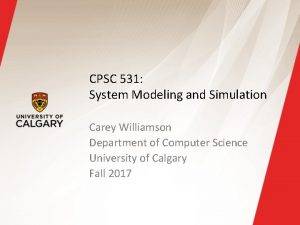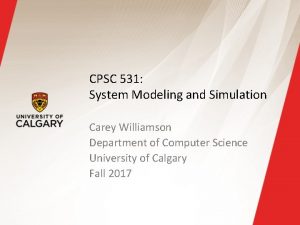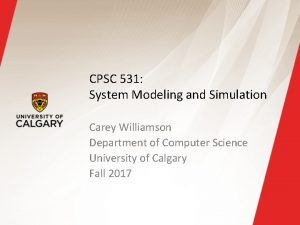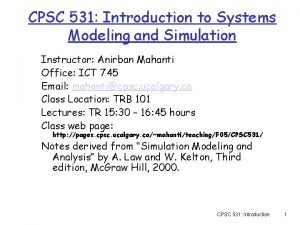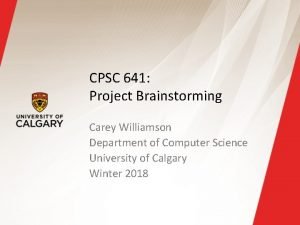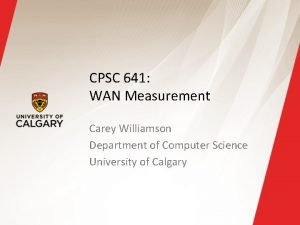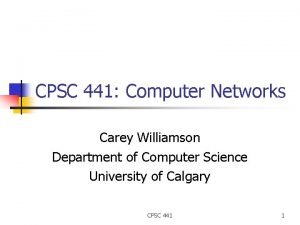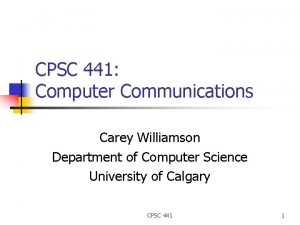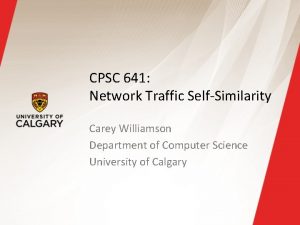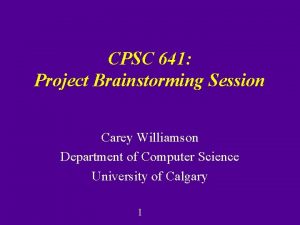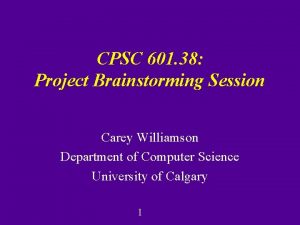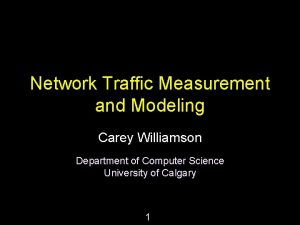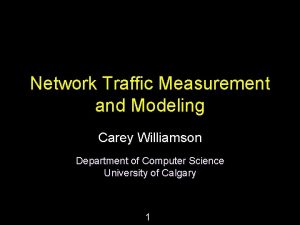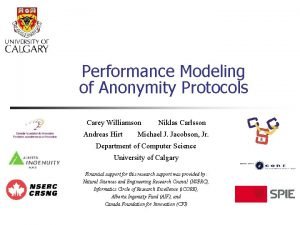CPSC 531 System Modeling and Simulation Carey Williamson





































- Slides: 37

CPSC 531: System Modeling and Simulation Carey Williamson Department of Computer Science University of Calgary Fall 2017

Outline § Probability and random variables — Random experiment and random variable — Probability mass/density functions — Expectation, variance, correlation § Probability distributions — Discrete probability distributions — Continuous probability distributions — Empirical probability distributions 2

Random Experiment § 3

Probability of Events § 4

Joint Probability § 5

Independent Events § 6

Mutually Exclusive Events § 7

Union Probability § 8

Conditional Probability § 9

Types of Random Variables § Discrete — Random variables whose set of possible values can be written as a finite or infinite sequence — Example: number of requests sent to a web server § Continuous — Random variables that take a continuum of possible values — Example: time between requests sent to a web server 10

Probability Density Function (PDF) § 11

Cumulative Distribution Function (CDF) § 12

Expectation of a Random Variable § 13

Properties of Expectation § 14

Misuses of Expectations § Multiplying means to get the mean of a product § Example: tossing three coins — X: number of heads — Y: number of tails — E[X] = E[Y] = 3/2 E[X]E[Y] = 9/4 — E[XY] = 3/2 E[XY] ≠ E[X]E[Y] § Dividing means to get the mean of a ratio 15

Variance of a Random Variable § 16

Variance of a Random Variable § Variance: The expected value of the square of distance between a random variable and its mean where, μ= E[X] § Equivalently: σ2 = E[X 2] – (E[X])2 17

Properties of Variance § 18

Coefficient of Variation § 19

Covariance § 20

Covariance § x y xy p(x) 0 3 0 1/8 1 2 2 3/8 2 1 2 3/8 3 0 0 1/8 xy p(xy) 0 2/8 2 6/8 21

Correlation § Negative linear correlation -1 No correlation Positive linear correlation 0 +1 22

Autocorrelation § Negative linear correlation -1 No correlation Positive linear correlation 0 +1 23

Demo: Correlation and Autocorrelation § Correlation (if desired) can be induced by sharing or re-using random numbers between two (or more) random variables § Example: height and weight of medical patients § Example: a coin that remembers some of its recent history Negative linear correlation -1 No correlation Positive linear correlation 0 +1 24

Geometric Distribution § 25

Example: Geometric Distribution Geometric distribution PMF Geometric distribution CDF

Uniform Distribution § PDF CDF 27

Uniform Distribution Properties § 28

Exponential Distribution § 29

Example: Exponential Distribution Exponential distribution PDF Exponential distribution CDF

Light Bulb Testing (1 of 5) § Scenario: Walmart has a giant bin of lightbulbs on sale. You buy one and bring it home for testing and observation. § Assume: All light bulbs last exactly 100 hours. § Observation: Your light bulb has worked for 70 hours. § Question: How much longer is it expected to last? § Answer: 30 hours 31

Light Bulb Testing (2 of 5) § Scenario: Walmart has a giant bin of lightbulbs on sale. You buy one and bring it home for testing and observation. § Assume: Half of the light bulbs last exactly 50 hours, while the other half last exactly 150 hours. The mean is 100 hours. § Observation: Your light bulb has worked for 70 hours. § Question: How much longer is it expected to last? § Answer: 80 hours 32

Light Bulb Testing (3 of 5) § Scenario: Walmart has a giant bin of lightbulbs on sale. You buy one and bring it home for testing and observation. § Assume: Half of the light bulbs last exactly 50 hours, while the other half last exactly 150 hours. The mean is 100 hours. § Observation: Your light bulb has worked for 40 hours. § Question: How much longer is it expected to last? § Answer: 60 hours 33

Light Bulb Testing (4 of 5) § Scenario: Walmart has a giant bin of lightbulbs on sale. You buy one and bring it home for testing and observation. § Assume: Light bulbs have a working duration that is uniformly distributed (continuous) between 50 hours and 150 hours. The mean is 100 hours. § Observation: Your light bulb has worked for 70 hours. § Question: How much longer is it expected to last? § Answer: 40 hours 34

Light Bulb Testing (5 of 5) § Scenario: Walmart has a giant bin of lightbulbs on sale. You buy one and bring it home for testing and observation. § Assume: Light bulbs have a working duration that is exponentially distributed with a mean of 100 hours. § Observation: Your light bulb has worked for 70 hours. § Question: How much longer is it expected to last? § Answer: 100 hours 35

Memoryless Property § 36

Example: Exponential Distribution § 37
 Cpsc 531
Cpsc 531 Cpsc 531
Cpsc 531 Cpsc 531
Cpsc 531 Cpsc 531
Cpsc 531 Guilherme carey ou william carey
Guilherme carey ou william carey Helen erickson nursing theory
Helen erickson nursing theory Simulation modeling and analysis law kelton
Simulation modeling and analysis law kelton Pharmaceutical simulation and modeling
Pharmaceutical simulation and modeling Introduction to modeling and simulation
Introduction to modeling and simulation Biomedical modeling and simulation
Biomedical modeling and simulation Simulasi adalah
Simulasi adalah Site:slidetodoc.com
Site:slidetodoc.com Relational modeling vs dimensional modeling
Relational modeling vs dimensional modeling 531 area code
531 area code Network slicing onap
Network slicing onap 531 warm up
531 warm up Amg 531
Amg 531 Cse 531
Cse 531 Nature of simulation
Nature of simulation Basic simulation modeling
Basic simulation modeling Fda vs brown and williamson
Fda vs brown and williamson Trait and factor theory steps
Trait and factor theory steps Eg williamson trait and factor theory
Eg williamson trait and factor theory Williamson act pros and cons
Williamson act pros and cons Dick and carey model
Dick and carey model Dick and carey design model
Dick and carey design model Bethan williamson
Bethan williamson Eter sentezi
Eter sentezi Eteres
Eteres Micah williamson
Micah williamson Amy williamson iowa
Amy williamson iowa Cara menolong orang jatuh ke laut
Cara menolong orang jatuh ke laut Lent a williamson iris
Lent a williamson iris Sintesi di williamson
Sintesi di williamson Bloody williamson
Bloody williamson Jennifer belknap williamson
Jennifer belknap williamson Intramolecular williamson ether synthesis
Intramolecular williamson ether synthesis Dr emma williamson
Dr emma williamson
